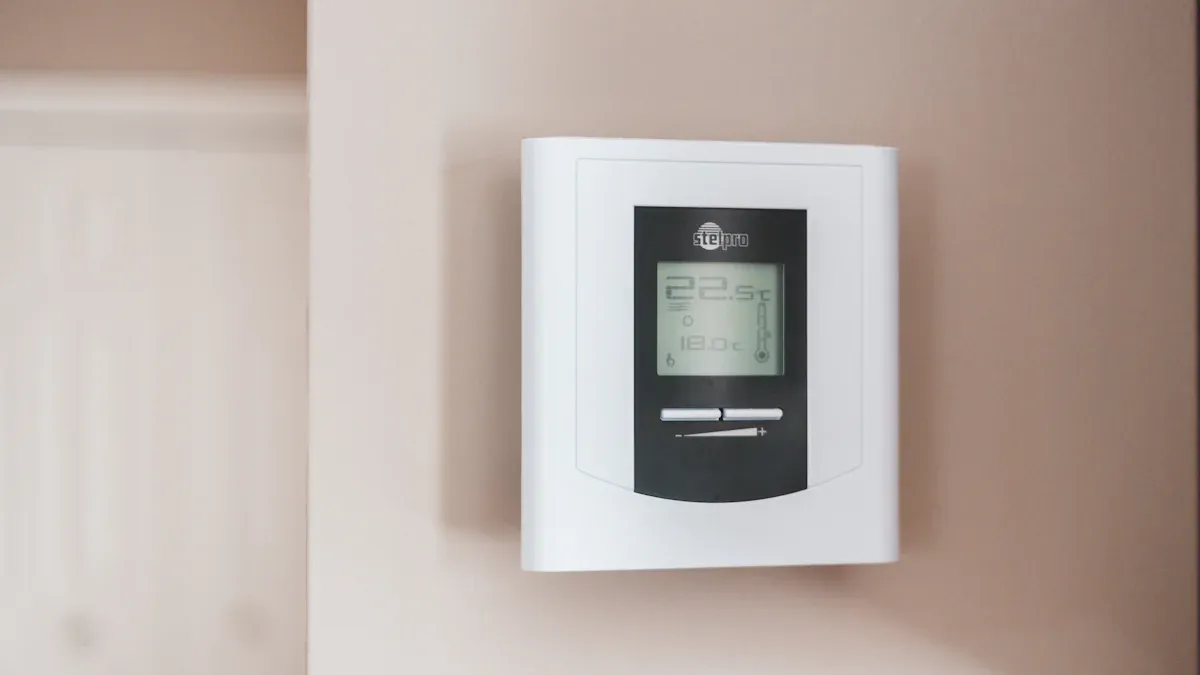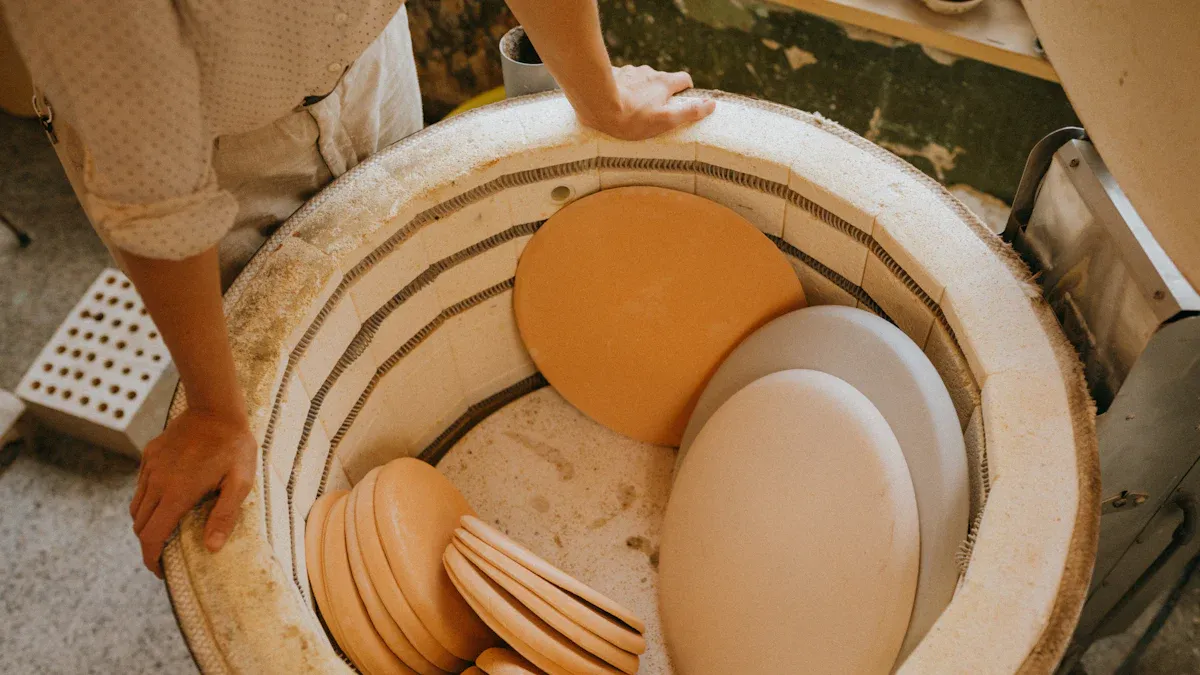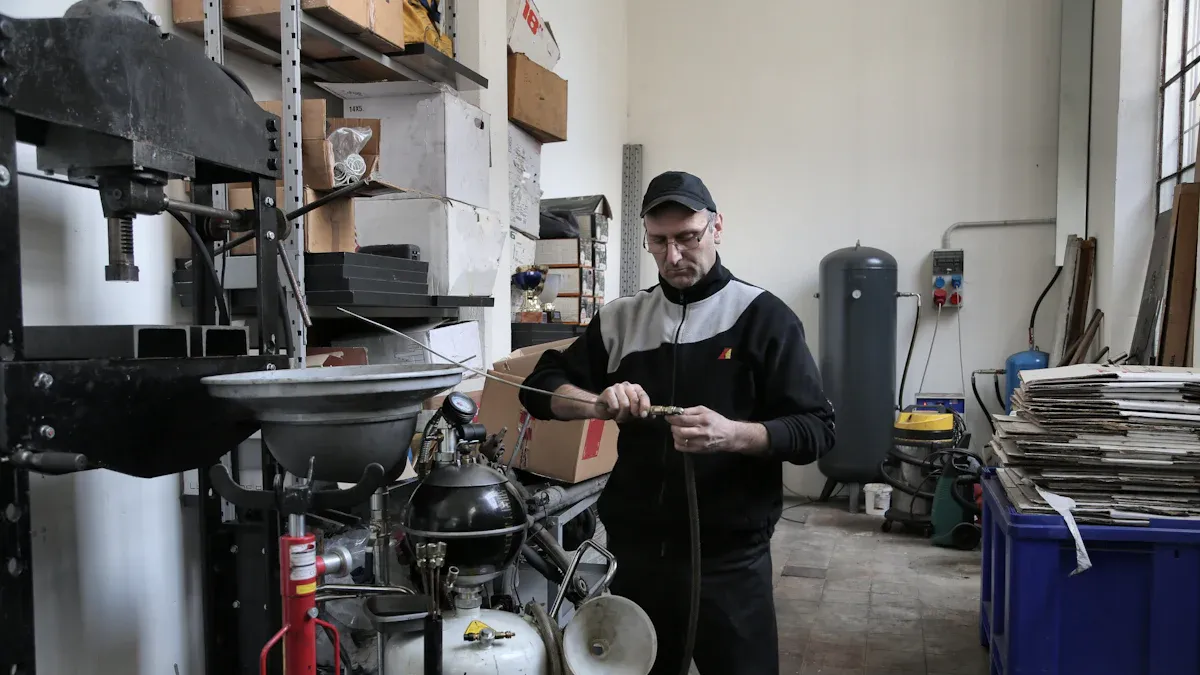
You must select the right kiln element for your kiln by matching its specifications to your kiln’s data plate. Proper maintenance extends the life of your kiln elements. Производители нагревательных элементов, like Электрическое отопление Цзиньчжун, produce everything from a professional kiln нагревательный элемент to нагревательные элементы бытовых приборов. Always condition a new Heating Element with a slow, empty firing. This process forms a protective layer on the elements, ensuring your kiln performs reliably. Your firing temperature directly impacts the lifespan of the elements in your kiln.
Element Lifespan by Firing Temperature | Firing Temperature | Average Lifespan (Firings) | |—|—| | Lower temperatures (bisque) | 200+ | | Regular firing (cone 6) | ~100 | | High temperatures (cone 10) | ~50 | | Mixed (bisque and cone 6) | 100-200 |
How to Select the Right Kiln Heating Element

Choosing the correct kiln heating element is the first step toward successful and reliable firings. You must look beyond a simple replacement and consider the specific needs of your kiln and your artistic practice. This ensures safety, efficiency, and longevity.
Match Elements to Your Kiln Model
Your kiln is a precision instrument. Its elements are not interchangeable with other models. You must install the exact elements designed for your specific kiln.
Why OEM Specifications Matter
Original Equipment Manufacturer (OEM) specifications guarantee a perfect match. Elements built to these specs have the correct length, coil diameter, and resistance. Using an incorrect part can lead to poor firing results, damage to the kiln’s electronics, or even create a fire hazard. Sticking to OEM specs ensures your kiln operates safely and as intended.
How to Find Your Kiln’s Data Plate
Every kiln has a metal data plate that contains its vital statistics. You can usually find this plate attached to the side of the control box or on the kiln body itself. It lists critical information you will need:
- Номер модели
- Serial Number
- Напряжение (вольт)
- Мощность (Вт)
- Amperage (Amps)
- Maximum Firing Temperature
Совет от профессионала: Take a clear photo of your data plate with your phone. This gives you a permanent, easy-to-access record for future parts ordering.
Using Manufacturer Charts for Part Numbers
Once you have your kiln’s model number, visit the manufacturer’s website. Most manufacturers provide detailed charts that cross-reference kiln models with the correct part numbers for their kiln elements. This is the most reliable way to confirm you are ordering the right set. If you cannot find the information online, call the manufacturer’s technical support with your data plate information handy.
Understand Kiln Element Specifications
Knowing the technical details of elements helps you make informed decisions. The alloy type, wire thickness, and electrical properties all play a role in performance.
Alloy Types: Kanthal A-1 vs. APM
Most electric kilns use elements made from an iron-chromium-aluminum (FeCrAl) alloy. The two most common types you will encounter are Kanthal A-1 and Kanthal APM.
- Kanthal A-1 is the industry standard. It is a robust and reliable alloy suitable for most hobby and light production work, especially for firings up to cone 8.
- Kanthal APM is a premium, advanced powder-metallurgical alloy. It offers superior structural stability and a longer lifespan at very high temperatures.
While both are excellent, they have different maximum operating temperatures. Kanthal APM offers a slight edge for high-temperature durability.
| Нагревательный элемент | Maximum Continuous Operating Temperature |
|---|---|
| Kanthal® A-1 | 1400ºC (2550ºF) |
| Kanthal® APM | 1425ºC (2600ºF) |
Wire Gauge (Thickness) and Element Life
The thickness of the element wire, known as its gauge, directly impacts its lifespan. A thicker wire contains more metal mass. It can withstand more heating and cooling cycles before it degrades. While thicker-gauge elements cost more initially, they often provide a longer service life, reducing the frequency of replacements.
Resistance (Ohms) and Its Importance
Resistance (measured in ohms) dictates how much heat an element produces. Your kiln requires a specific total resistance from all its elements combined. This ensures the kiln reaches the target temperature correctly. Installing an element with the wrong resistance will cause the kiln to fire too slowly or too quickly, and it can strain the relays and control board.
Voltage and Wattage Compatibility
You must match the elements to your kiln’s voltage. A kiln heating element designed for a 240V kiln will not work properly in a 208V kiln, and vice versa. The voltage and resistance together determine the wattage, or power output. Using the correct elements ensures the kiln delivers the right amount of heating power for predictable, even firings.
When to Upgrade Your Kiln Elements
Sometimes, the standard replacement is not the best choice. Upgrading your kiln elements to a premium alloy like APM can be a strategic investment.
Benefits of APM for High-Fire Applications
APM elements truly shine under demanding conditions. You should strongly consider an upgrade if your work involves any of the following.
- Frequent High-Temperature Firings: Если вы consistently fire to cone 10 or higher, APM elements will last significantly longer than standard A-1 elements.
- Crystalline Glazes: The long holds and slow cooling cycles required for crystalline glaze formation cause accelerated wear on standard elements. APM’s unique structure resists this type of stress, making it ideal for this application.
- Production Pottery: For potters firing multiple times a week, the extended lifespan of APM elements means less downtime and lower long-term maintenance costs.
Analyzing Cost vs. Longevity
APM elements have a higher upfront cost than A-1 elements. However, their extended lifespan in high-stress environments can make them more economical over time. If you replace standard elements twice as often, the initial savings are quickly lost. You should analyze your firing frequency and temperature to determine the long-term value.
Is an Upgrade Right for Your Firing Style?
The decision to upgrade depends entirely on how you use your kiln.
- If you primarily bisque fire or work with low-to-mid-range glazes (up to cone 6), standard Kanthal A-1 elements are perfectly adequate and cost-effective.
- If you are a production potter, teach high-fire ceramics, or specialize in techniques like crystalline glazes, upgrading to Kanthal APM is a smart investment that will pay off in durability and fewer replacements.
A Step-by-Step Guide to Kiln Element Installation
Replacing a kiln heating element is a manageable task that saves you time and money. This guide provides a clear path from preparation to final connection. You can ensure a safe and successful installation by following these steps methodically.
Safety First: Preparing for Installation
You must prioritize safety above all else. You are working with high-voltage electrical components. Never rush the preparation phase.
Essential Safety Protocols
Your personal safety is non-negotiable. Always wear safety glasses to protect your eyes from dust and debris. It is also wise to wear gloves, as old elements can be brittle and sharp. Work in a well-lit area so you can see every connection clearly.
Disconnecting Power at the Breaker
Unplugging the kiln is not enough. You must completely de-energize the circuit. Go to your building’s breaker box and switch the specific breaker for your kiln to the “OFF” position.
⚠️ Safety Alert: You should place a piece of tape over the breaker switch with a note like “Do Not Turn On – Kiln Maintenance in Progress.” This prevents someone from accidentally restoring power while you are working.
Required Tools for the Job
Gathering your tools beforehand makes the process smoother. You will typically need:
- Safety Glasses and Gloves
- Needle-Nose Pliers
- A Phillips Head Screwdriver
- A Nut Driver or Wrench Set
- A Shop Vacuum with a Brush Attachment
Removing the Old Kiln Elements
With the power off and tools ready, you can begin removing the worn kiln elements. Work carefully to avoid damaging the soft firebrick of your kiln.
Taking Out Old Element Pins
Use needle-nose pliers to gently grip and pull out the small metal pins holding the element coils in place. Old pins can be brittle, so pull them straight out of the brick.
Carefully Extracting Worn Coils
Once the pins are out, you can lift the old element coils from their grooves. Start at one end and carefully work your way around the kiln, extracting the coil without scraping the brick.
Disconnecting the Terminal Wires
Follow the element “pigtail” through the kiln wall to the control box. Open the control box cover. Locate where the element wire connects to the terminal block and use your screwdriver or nut driver to loosen the connection and remove the wire.
Cleaning Debris from Brick Grooves
After removing the old elements, thoroughly vacuum the empty grooves and the entire interior of the kiln. Use a soft brush to dislodge any loose brick particles or element scale. A clean groove is essential for proper seating of the new elements.
Installing the New Kiln Heating Element
Now you will install the new components. Precision and care during this stage are critical for the longevity of your new elements.
How to Stretch New Coils Correctly
New elements arrive tightly coiled and must be stretched to the correct length before installation. Uniform stretching is crucial for a satisfactory lifespan.
- You should first stretch the coil to about half of its final required length.
- Next, you will examine the coil for any sections that are still wound too closely together.
- Selectively pull on these tight sections to create a uniform stretch along the entire length.
- If you accidentally overstretch a section, you can insert a small metal rod into the coil and use pliers to gently compress it back.
Seating Coils Evenly in Grooves
Carefully place the newly stretched coil into the clean brick grooves. The coil should sit securely at the bottom of the groove without being forced. Ensure there are no kinks or overlapping sections.
Securing the Element with New Pins
Use the new pins provided with your element set. Gently push the pins into the brick, crossing over the coil to hold it in place. Follow the manufacturer’s recommended pin placement for your kiln model.
Ensuring Tight Terminal Connections
Feed the new element pigtail through the kiln wall and into the control box. Securely fasten the wire to the correct terminal. A loose connection can generate excess heat, potentially melting the wire or damaging the terminal block. Double-check that every connection is snug.
Conditioning New Elements for a Long Life
You have successfully installed your new kiln elements. Your final step before loading any artwork is the most important one for ensuring their longevity: the conditioning fire. You must not skip this process. It is a slow, empty firing that prepares the new coils for the stress of regular use.
Why a Conditioning Fire is Crucial
Think of a conditioning fire as the “break-in” period for your new components. This initial heating cycle is essential for maximizing the lifespan and performance of the alloy. A proper conditioning fire provides several key benefits:
- It forms a vital protective coating on the wire surface.
- It helps stabilize the new coils within the brick grooves.
- It burns off any residual oils or contaminants from the manufacturing process.
- It prevents premature aging and brittleness.
Rushing this step can significantly shorten the life of your investment, leading to early failures and inconsistent firings.
How the Protective Oxide Layer Forms
The magic of a conditioning fire happens at a molecular level. Your new elements are made from an iron-chromium-aluminum (FeCrAl) alloy. When you slowly heat this alloy in an oxygen-rich environment (your empty kiln), the aluminum migrates to the surface. It reacts with oxygen to form a thin, durable, and non-conductive layer of aluminum oxide (Al₂O₃). This gray, matte layer acts as a protective shield. It guards the raw metal underneath from further oxidation and degradation during the intense heat of future firings.
A Sample Conditioning Fire Schedule
You should always consult your kiln or element manufacturer for their recommended schedule. However, a typical conditioning program is a simple, slow ramp to a moderate temperature. You must run this program in a completely empty kiln.
Совет от профессионала: Keep the kiln lid propped open about an inch and leave the peepholes open during this firing. Proper ventilation is critical for supplying the oxygen needed to form a strong oxide layer.
Here is a common schedule you can adapt:
| Segment | Ramp Rate (per hour) | Target Temperature | Hold Time |
|---|---|---|---|
| 1 | 250°F (139°C) | 1500°F (815°C) | 1 Hour |
After the hold, you should let the kiln cool down naturally. Once this firing is complete, your new elements are fully prepared for their first glaze load.
Essential Maintenance for Maximum Kiln Element Longevity
Proper maintenance is the most effective strategy you can employ to get the most out of your kiln elements. Consistent care and smart firing habits protect your investment. These practices reduce long-term costs and lead to more predictable, successful firings.
Your Routine Inspection Checklist
You should make visual inspections a regular part of your studio routine. Catching problems early prevents failed firings and costly damage. This simple act of kiln maintenance can save you significant trouble.
What to Look For: Slumping, Bulging, and Breaks
You need to train your eye to spot the tell-tale signs of wear. When you look inside your kiln, pay close attention to the condition of the coils.
- Slumping or Sagging: Elements that are drooping out of their grooves are a common sign of age. This happens after many firing cycles and can lead to uneven heating.
- Bulging or Hot Spots: You may see a section of a coil that glows much brighter than the rest during firing. This indicates a “hot spot” where the element is thinning and close to failure.
- Breaks: An obvious crack or separation in a coil is a definitive failure. A broken element will not conduct electricity, creating a dead zone in your kiln and preventing it from reaching temperature.
How Often to Inspect Your Kiln Elements
Consistency is key for effective kiln maintenance. You should adopt a two-tiered inspection schedule.
- Quick Visual Check: Before every firing, take a moment to glance inside the kiln for any obvious issues like a broken element or severe sagging.
- Thorough Inspection: Every 10-15 firings, you should perform a more detailed check. Look closely at each coil for the subtle signs of wear mentioned above.
Checking and Tightening Terminal Connections
Loose electrical connections are a hidden danger. They create high resistance, which generates intense heat. This can melt wires and damage the terminal block. With the power disconnected at the breaker, you should periodically open your control box and check that the element terminal connections are snug. A quick turn of a nut driver can prevent a major repair.
Adopting Best Firing Practices for Your Kiln
How you fire your kiln directly impacts the lifespan of your elements. Aggressive firing schedules create unnecessary stress, while thoughtful programming promotes longevity.
The Impact of Rapid Firing Cycles
Firing your kiln as fast as possible places significant thermal shock on the elements. Rapid heating and cooling cause the metal to expand and contract violently. This repeated stress accelerates metal fatigue and can shorten the life of your coils. You should use moderate ramp rates whenever your project allows.
How Hold Times at Peak Temperature Affect Longevity
Holding your kiln at a high temperature for extended periods is one of the fastest ways to degrade your elements. This is especially true for crystalline glaze cycles or slow cooling programs.
Repeated heating and cooling cycles also create tiny fissures in the oxide layer. These cracks expose the raw metal core to further oxidation, accelerating the failure process.
The Critical Role of Proper Kiln Ventilation
Proper ventilation does more than just remove fumes; it is essential for element health. The protective oxide layer on your elements needs oxygen to form and maintain itself. A well-ventilated kiln ensures an oxygen-rich atmosphere.
- Downdraft Vents are considered the most effective system. They actively pull fresh air through the kiln, promoting even heat distribution and supplying the oxygen needed for a long element life.
- Canopy Hoods primarily remove ambient heat and fumes from the room. They are less effective at creating the internal airflow that benefits the elements.
The ideal ventilation rate depends on your room size and kiln output. You should consult an HVAC professional to design a system that meets your specific needs for fume removal and temperature control.
How to Prevent Element Contamination
Foreign materials are the enemy of your heating elements. You must keep the interior of your kiln clean to prevent contamination that can cause immediate and irreversible damage.
Keeping Kiln Wash Off Your Elements
You should apply kiln wash carefully to your shelves and never to the kiln’s brick walls. Kiln wash is an insulator. If it flakes off a shelf and lands on an element, it will block heat from radiating. This creates an intense hot spot that will quickly burn out that section of the coil.
Protecting Elements from Glaze Drips
Molten glaze is highly corrosive to heating elements. A single drop of glaze on a hot coil can eat through the metal, causing an instant break. You can prevent this by avoiding over-glazing your pieces and ensuring you have at least a half-inch of unglazed space at the bottom of every pot.
The Importance of Regular Kiln Vacuuming
Over time, your kiln will accumulate dust and small bits of brick or clay. You should vacuum the interior of your kiln regularly, especially the element grooves. This simple task removes debris that could otherwise melt onto your elements during a firing, causing contamination and damage.
Troubleshooting Common Kiln Element Problems

Even with perfect maintenance, your kiln elements will eventually wear out. Knowing how to diagnose problems helps you intervene before a firing is ruined. You can identify and address issues with your kiln heating element by learning to spot the signs of failure.
How to Identify a Failing or Broken Element
You can often find a problem before it causes a major failure. Regular observation is your best diagnostic tool.
Signs of a Dying Kiln Element
You should look for clear visual cues that signal an element is nearing the end of its life. These signs of wear indicate it is time for a replacement.
- Sagging or Stretching: Coils that droop significantly out of their grooves.
- Brittleness or Cracks: Visible fissures or breaks along the coil.
- Thinning Areas: Sections of the coil that look noticeably skinnier, which create hot spots.
- Uneven Glow: During heating, some parts of the element glow dimmer or not at all.
Using a Multimeter to Test Resistance
A multimeter gives you a definitive electrical measurement. With the kiln power disconnected at the breaker, you can test each element’s resistance (ohms). Compare your reading to the manufacturer’s specification for that element.
A kiln element is showing significant wear and reduced performance if its resistance reading is more than 10% off from the original specification. This deviation confirms the element is failing.
Visual Confirmation of a Break or Damage
Sometimes the problem is obvious. A complete break in a coil is an unmistakable failure. You can easily spot this with a quick visual check inside a cool kiln. This kind of damage will prevent the kiln from reaching its target temperature.
Diagnosing Common Firing Issues
The results of your firing often tell a story about the health of your kiln. You can trace many issues back to the elements.
Why Your Kiln is Firing Slowly
One of the most common symptoms of aging elements is a slow firing cycle. As elements degrade, their electrical resistance increases. This change reduces their heat output, forcing the kiln to work longer to reach the target temperature.
Understanding Controller Error Codes
Your kiln’s digital controller is designed to detect problems. It will often display an error code when the heating rate is too slow.
E-1: This common error means the temperature is rising slower than about 12°F per hour.E-3: This code appears if the kiln temperature drops 50°F below a set hold temperature.
These codes frequently point to worn or broken elements.
Troubleshooting Uneven Heating
If your finished pieces show inconsistent results, you likely have uneven heating. Aging elements degrade at different rates, creating hot and cold zones inside the kiln. You can map these zones by placing witness cones on each shelf. The cones will clearly show which areas of the kiln are not reaching the correct temperature.
Replacement Strategy: One Element or a Full Set?
When you find a failed element, you must decide whether to replace one or all of them. Your choice impacts future firing consistency.
Why Replacing a Full Set is Recommended
It is almost always best to replace all the elements at once. Since they have all gone through the same number of firings, they have worn down at a similar rate. Installing one new, powerful element among a set of old, weaker ones will worsen uneven heating and stress the new component.
When a Single Kiln Element Fails Prematurely
The only exception is if a single element fails very early in its life. This can happen due to a manufacturing defect or physical damage, like a glaze drip. In this specific case, you can replace just the one failed element.
You select the right elements for your kiln by matching specifications to your firing style. Consistent maintenance ensures the longevity of your kiln elements. These practices give your kiln reliable firings and reduce operational costs for your kiln. You should take a moment to inspect your kiln today. A quick check of your kiln can prevent a failed firing tomorrow.
ЧАСТО ЗАДАВАЕМЫЕ ВОПРОСЫ
### How do I know when to replace my elements?
You should replace your elements when firings take much longer than usual. Other signs include visible sagging, cracks in the coils, or frequent controller errors like E-1. A thorough visual inspection will confirm the need for replacement.
### Can I repair a broken element?
You should not repair a broken element. A repair creates a weak point with high resistance. This spot will fail again quickly and cause uneven heating in your kiln. Always replace a broken element instead of attempting a repair.
### Why did my new element fail so quickly?
Premature failure usually results from contamination or improper installation. A single drop of glaze can destroy a coil. Skipping the initial conditioning fire also drastically shortens an element’s life. Always ensure the kiln is clean and conditioned.
### What’s the white powder on my kiln floor?
That powder is likely aluminum oxide. It is a normal byproduct of element aging, as the protective layer flakes off over many firings. You should vacuum this debris out regularly to keep your kiln and element grooves clean.
### Do I need to condition my elements every time I fire?
No. You only perform a conditioning fire once when the elements are brand new. This single, slow firing builds the essential protective oxide layer. All subsequent firings can use your normal schedules without repeating the conditioning process.
### Is it okay to fire my kiln empty?
Yes, you can fire your kiln empty. This is required for the initial conditioning fire. However, remember that every firing cycle, loaded or empty, contributes to the wear on your elements and reduces their total lifespan.
### How do I test an element with a multimeter?
First, disconnect the kiln from power at the breaker. Set your multimeter to measure resistance (ohms Ω). Touch one probe to each end of the element’s terminal wires. Compare the reading to the manufacturer’s specification for that element.
💡 Tip: A resistance reading that is 10% higher than the original specification indicates the element is significantly worn and should be replaced soon.


